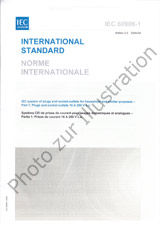Wir benötigen Ihre Einwilligung zur Verwendung der einzelnen Daten, damit Sie unter anderem Informationen zu Ihren Interessen einsehen können. Klicken Sie auf "OK", um Ihre Zustimmung zu erteilen.

IEC 61097-4-ed.4.0-CMV
Global maritime distress and safety system (GMDSS) - Part 4: Inmarsat-C ship earth station and Inmarsat enhanced group call (EGC) equipment - Operational and performance requirements, methods of testing and required test results
Name übersetzen
NORM herausgegeben am 20.2.2024
Informationen über die Norm:
Bezeichnung normen: IEC 61097-4-ed.4.0-CMV
Ausgabedatum normen: 20.2.2024
SKU: NS-1168203
Zahl der Seiten: 67
Gewicht ca.: 201 g (0.44 Pfund)
Land: Internationale technische Norm
Kategorie: Technische Normen IEC
Kategorie - ähnliche Normen:
Die Annotation des Normtextes IEC 61097-4-ed.4.0-CMV :
IEC 61097-4:2024 CMV contains both the official standard and its commented version. The commented version provides you with a quick and easy way to compare all the changes between IEC 61097-4:2024 edition 4.0 and the previous IEC 61097-4:2012+AMD1:2016+AMD2:2019 CSV edition 3.2. Furthermore, comments from IEC TC 80 experts are provided to explain the reasons of the most relevant changes, or to clarify any part of the content. IEC 61097-4:2024 specifies the performance requirements and methods of testing for Inmarsat-C ship earth stations (SES) capable of transmitting and receiving direct-printing communications, and for enhanced group call (EGC) receivers, for use in the GMDSS and for use for long-range identification and tracking (LRIT). The available variants are: Class 0: An EGC receiver, either stand-alone or an element of a GMDSS installation in accordance with the Inmarsat design and installation guidelines (DIGs) for GMDSS installations. Class 1: A basic SES providing shore-to-ship and ship-to-shore message transfer only. Class 2: As class 1 but with EGC as an alternative to shore-to-ship transfer using a shared receiver. Class 3: As class 1 but with EGC using an independent receiver. NOTE 1 The 34th session of the IMO Sub-Committee on Radiocommunications decided that class 2 equipment would be adequate to provide sufficient availability for the reception of maritime safety information for the GMDSS. This document complies with IMO performance requirements stated in the normative references, Inmarsat technical characteristics and test procedures, and IEC 60945 general requirements except where modifications are explicitly stated in this document. Technical characteristics essential to GMDSS and LRIT operation as defined by the IMO are identified. All text of this document, whose wording is identical to that in IMO SOLAS Convention 1974 as amended in 1988 and Resolutions MSC.513(105), MSC.263(84) and MSC.306(87) is printed in italics and reference made to the Resolution/Recommendation and subclause number. This document covers equipment construction and testing. Matters relating to installation can be found in the Inmarsat Maritime design and installation guidelines (see Bibliography). Those to be found in IMO Resolutions MSC.513(105), MSC.263(84) and MSC.306(87) are reproduced in Annex A. Responsibility for type approval of Inmarsat-C and Inmarsat-EGC is vested in Inmarsat by IMO Resolutions MSC.513(105) and MSC.306(87) (see 4.2.1). Therefore, this document does not reproduce Inmarsat test procedures in full but refers to where they are given in Inmarsat documentation cited in the normative references to this document (Annex C). NOTE 2 For the purposes of this document the terms Inmarsat C, Inmarsat-C, Inmarsat Standard-C, Standard-C refer to the same equipment.
Empfehlungen:
Aktualisierung der technischen Normen
Wollen Sie sich sicher sein, dass Sie nur die gültigen technischen Normen verwenden?
Wir bieten Ihnen eine Lösung, die Ihnen eine Monatsübersicht über die Aktualität der von Ihnen angewandten Normen sicher stellt.
Brauchen Sie mehr Informationen? Sehen Sie sich diese Seite an.



 Cookies
Cookies
